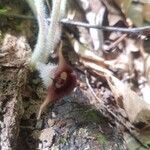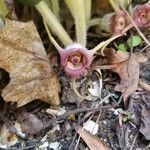Plants hairy, especially the petioles and cal; lvs cordate-rotund to cordate-reniform, mostly 8–12 cm wide at anthesis, larger at maturity; peduncle stout, 2–5 cm; fls 2–4 cm; calyx tube short, erect, the lobes spreading or reflexed; 2n=26. Rich woods, usually in colonies; N.B. and Que. to Ont. and Minn., s. to N.C., n. Ala., and n. La. Apr., May. Var. canadense, with essentially the range of the species, has the cal-lobes spreading from the base, curved upward beyond the middle, and gradually narrowed into a revolute-margined slender tip 0.5–2 cm. (A. acuminatum, the extreme form) Var. reflexum (E. P. Bicknell) B. L. Rob., from N.Y. to Mich. and Io., and southward, commoner in the Middle West, has the cal-lobes reflexed, often closely appressed to the ovary, triangular, abruptly contracted into a short, tubular, 2–4 mm tip. (A. ambiguum, a form intermediate to var. canadense)
A small evergreen herb. It can grow 1 m tall. It lies along the ground and has a ginger smell. It has a slender underground stem or rhizome. The leaves are dark green, hairy and heart shaped. They are 5-20 cm across. The flowers are urn shaped and purple brown. They are on short stalks near the ground.







